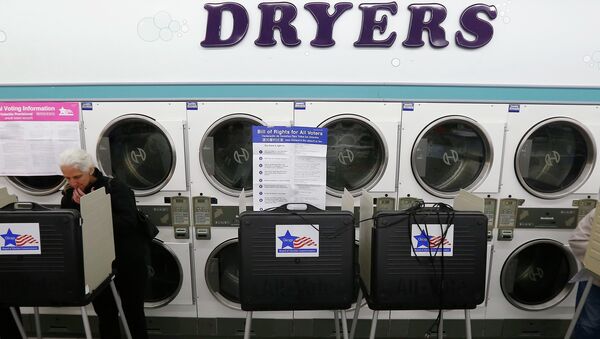WASHINGTON, November 5 (RIA Novosti) – Turnout in US midterm elections is historically low and this trend is more pronounced among African-American and Hispanic communities who face additional hurdles such as voter ID laws and socioeconomic disadvantages, experts told RIA Novosti on late on Tuesday.
"Minority turnouts in midterm elections are historically low relative to minority turnout in presidential elections. This is the same trend you see for the bulk of most Americans but it is more pronounced for minorities," associate director of UMass Poll research center Tatishe Nteta said.
Lower minority turnout is attributed to the costs associated with voting, from acquiring information about candidates to the time it takes to vote, all of which have a socioeconomic dimension, said Nneta. Compounding the problem is that Latinos and African Americans are more likely to have working class jobs from which they can't get time off to vote, he noted.
Republican controlled state legislatures and judiciaries passed measures to end same-day voter registration, restrict early voting and apply the controversial state voter ID laws, the expert said, adding that these laws benefit Republicans at the polls as minorities historically vote for the Democratic party.
"If you can rig the rules of the game to ensure that more of your supporters come out to vote and less of your opponent's supporters come out to vote… then you've won, you've won even if you haven't won the battle of ideas," Nteta said.
He cautioned against assuming restrictive voting laws are racist. "Race just happens to be correlated with partisan identity in this nation," the expert pointed out.
Matt Barreto, professor of political science at the University of Washington told RIA Novosti that candidates don't focus enough on minority communities.
"Candidates are focused on who they think are likely voters. This creates a cycle. Candidates don't invest as much in minority communities," Barreto said. "People aren't going to vote if they feel candidates aren't interested in their community."
People who have less time on their hands need to have more opportunities to vote, he said, adding that when early voting and other opportunities are cut and barriers created by adding ID requirements there will be a decrease in the minority vote.
In the last 2010 midterm election African Americans' turnout rate was 44 percent, Hispanic turnout was 31 percent, below 49 percent for Whites, according to US Census Data. Thirty states require a photo ID to vote, but 21 million citizens – mostly minorities and low income — don't have government photo identification, according to the American Civil Liberties Union.
Pew Research Center analysis shows voter turnout in midterm elections averages 40 percent, compared to around 60 percent for presidential elections.
On Tuesday, Americans voted in the midterm elections to elect 435 members of the House of Representatives, 36 senators, 36 governors and 46 state legislatures.



